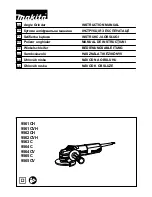
8
VMAR CHALLENGER 40ARF TRAINER
TM
R
R
R
R
R
PHASE 2 - WING ASSEMBLY.
R
R
R
R
R
STEP 2.2 - DRY ASSEMBLY OF THE
WING HALVES.
R
R
R
R
R
2.2.2
You will also need the following items that are not
included with your Challenger.
R
R
R
R
R
Pencil
R
R
R
R
R
Masking tape.
R
R
R
R
R
2.2.3
Remove the wing halves
[WL]
and
[WR]
from
the plastic bag they were shipped in. Examine the wing
halves carefully before proceeding.
R
R
R
R
R
2.2.4
Remove the protective tape and cardboard that
has been applied to the wire like aileron horns. These are
found near the wing roots. Peel the protective tape away
carefully.
R
R
R
R
R
2.2.5
Place the wings top side up on a table so that
the leading edge ("front") of the wing is away from you
and the ailerons are towards you. Position the left wing to
the left and the right wing to the right so that the wing
roots are facing each other.
R
R
R
R
R
2.2.6
Position the wing so that the ailerons and white
plastic aileron horns are hanging over the edge of the
table allowing the wing halves to lie flat on the table
surface with the yellow side of the wing facing down.
- First the easy part, the outboard ends of the wings are
called the "wing tips".
- Each wing half has a flat wooden face that is at the
opposite end from the wing tips. This flat wooden face is
called the "wing root". We will be joining the wing halves
shortly and the wing roots will end up contacting each
other.
- The back edge of the wing can move up and down. The
moveable section is called an "aileron". The ailerons are
mounted to the "trailing edge of the wing" using hinges.
- The front edge of the wing is rounded and is called the
"leading edge".
- The "bottom" of the wing is flat, the top of the wing is
curved to provide lift.
- The "wing spar joiner" is a slightly V shaped piece of
wood that will serve to join the wing halves together and
provide strength to the wing when in the air.
R
R
R
R
R
STEP 2.1 - TERMS TO REMEMBER
R
R
R
R
R
2.2.9
Examine the wooden wing spar joiner
[WJS]
.
Note that it is not straight. It has a slight V shape. Mark
a centre line at the apex of the V with a pencil. When
the wing spar joiner looks like a broad V it is right way
up. If the wing spar joiner looks like a broad upside down
V it is the wrong way up and should be turned over.
Pencil in arrows pointing up on both sides of the wing
spar joiner
R
R
R
R
R
2.2.7
Locate the two short wing joint dowels
[WJD]
.
Mark a centre line around each dowel with the pencil.
Insert a dowel into the hole in the left wing root that is
located closest to the leading edge of the left wing. Push
the dowel into the hole up to the half way mark denoted by
the pencil line.
R
R
R
R
R
1 Wing spar
joiner
[WJS]
made of wood
R
R
R
R
R
2 Wing joint
dowels
[WJD]
25 mm (1 in.)
long, wood
R
R
R
R
R
4 Wing
mounting bolts
[WB]
made of white plastic
R
R
R
R
R
2.2.1 To
dry assemble the wing you will need the right
wing half
[WR]
and the left wing half
[WL]
as shown
above and the following items from the Wing Parts Bag.
You will first be assembling the wing with no glue. We call
this a "dry assembly" and it is important to use no glue
until you have done the dry assembly to check everything
out.
R
R
R
R
R
2.2.8
Insert the second wing joint dowel into the hole in
the left wing root that is located closest to the trailing edge
of the left wing. Push the dowel into the hole up to the half
way mark denoted by the pencil line.
TOP OF RIGHT WING
BOTTOM OF LEFT WING
WR
WL
LEADING
EDGE
DOWEL
INSERTED
TO HALF
ITS
LENGTH
TRAILING
EDGE
VIEW OF LEFT
WING ROOT
LEFT
RIGHT
INSERT INTO WING HALVES SO THAT WING TIPS
ARE HIGHER THAN CENTRE WHEN WING UPRIGHT
WJS
MARK CENTRE LINE & "UP" ARROWS WITH PENCIL
UP
UP
AILERON
HORN









































